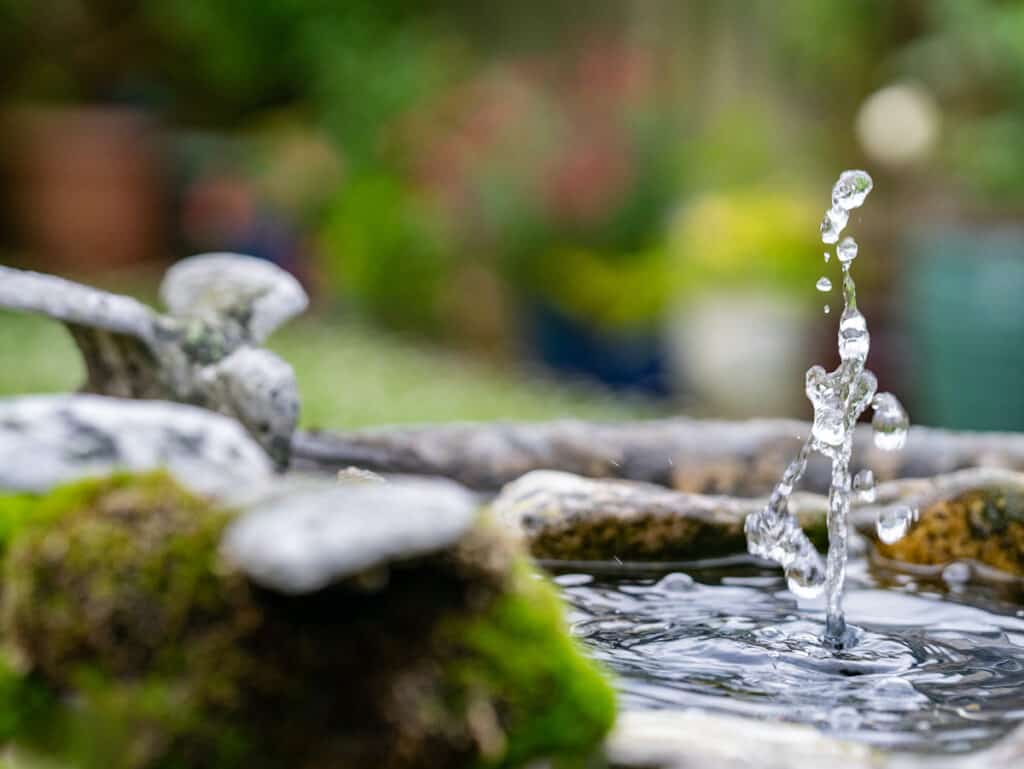Integrating Water Features Into Your Garden
Water animates a garden and brings it to life. Moving water brings its quiet music as it gurgles and splashes or shoots into the air and falls back into a pool below. Still water is hypnotic—a mirror that reflects the sky and trees overhead, then ripples and dances to scatter the image when touched by a breeze, only to re-form it once more. Water is an entirely delightful addition to the garden, especially when used with its inherent natural characteristics in mind.

In nature, water is drawn by gravity to run downhill and pool in low spots. For the most successful design, use these inherent qualities when incorporating water features into the garden. Locate a pool or pond in a low spot where water would naturally collect. A pool on top of a slope will look somehow strange and out of place, no matter how carefully you shape it or how beautifully you plant around it. But placed at the foot of the hill, the pool will make a lot more sense. Similarly, a cascade needs to run from high ground to low; it would seem odd running across level ground.
Water, both moving and still, is an essential element in Japanese gardens. Water can bring magic to your garden, too. Here are some guidelines for incorporating water features into your garden.
Still Water: If you want to have a reflecting pool, be sure to locate where it will have something to reflect. Still water mirrors the clouds above and nearby plants, too. The glistening surface draws and holds your attention. A garden pool need not be deep to work its magic. Unless you want to have fish, your garden pool can be shallow — 2 feet is plenty. A shallow pool is less work to maintain than a deep one. A pool with a dark bottom or liner will have the most reflective surface, and the dark depths below will look mysterious. On the other hand, light colored undersurface lets you see right to the bottom, which can be a design feature in itself if you have a mosaic or other design on the bottom. You can add interest to a pool by including statuary, plants in or near it, or a fountain.
A pool in a partly shaded location will be easiest to manage. A location in full sun will encourage algae growth. A pool in a spot surrounded by lots of trees will fill up with leaves, which will have to be removed before they decay.

Moving Water: Moving water animates the garden with its motion and musical sounds. Moving water can be as subtle as a slow trickle from a bamboo waterspout into a stone basin, or as dramatic as a fountain shooting a jet toward the sky. The quietest way to introduce moving water into your landscape is a simple waterspout that trickles into a catch basin below. There are single unit, wall mounted, or freestanding waterspouts that emanate from the head of a lion or cherub or other source and fall into a basin below. You can find these pieces in natural stone, cast or cultured stone, or lighter weight resin. There are also small bubblers to install in large olive jar or urn. All these devices use pumps to recirculate the water through the system.
You can find a wide variety of fountains, too, in many sizes and designs. A fountain captures the interplay of water and light. It can be small and subtle or big and dramatic, but it is not supposed to look like a natural feature. A fountain demands your attention. Its sound and motion draw you to it. Consider viewing angles when choosing a location for a fountain. A jet or spray is sublime when backlit by the sun. Also pay some heed to sightlines. How high and at what angle, should the water rise into the air in order to be visible from your chosen vantage point? Be mindful of scale and proportion, too. The basin or pool into which the water falls should be in scale with the rest of the landscape.
Many styles of pools and fountains are available. Find one that works in the space you have available, and that complements the overall style of your landscape and your house. Then enjoy the magic of water.








![Welcome to 114 Seafield Lane, situated on a corner lot and a full private acre with a deeded right of way to Quantuck Bay. This home is made for entertaining with an open kitchen that features 2 oversized islands, pantry and wet bar, library, and a spacious living room with fireplace that overlooks the grounds with an all weather porch perfect for all year enjoyment. Represented by @colleen_graning of @douglaselliman. [link in bio]](https://hamptonsrealestateshowcase.com/wp-content/uploads/sb-instagram-feed-images/472043326_18483682018030135_4434556661967553414_nfull.webp)
![Get ready to stir, shake, or sip as you plan an at-home holiday cocktail party! Whether you prefer bubbly or sophisticated cocktails, here are some chic accessories for a celebratory evening 🍾🥂 [link in bio]](https://hamptonsrealestateshowcase.com/wp-content/uploads/sb-instagram-feed-images/470932215_901131885558340_915943174166158286_nfull.webp)
![Ring in the New Year at @calissahamptons, where the Hamptons meets unparalleled celebration 🥂 Indulge in Mediterranean elegance, sip bubbly under the twinkle of chandeliers, and toast to 2025 with effortless style. This is the NYE party you won’t want to miss! [link in bio]](https://hamptonsrealestateshowcase.com/wp-content/uploads/sb-instagram-feed-images/471814094_670589388645280_7484117556192154580_nfull.webp)
![Start the new year in paradise! Turks & Caicos is calling, with its soft white sandy beaches, crystal-clear waters, and vibrant marine life. Stay at the luxurious @bluehaventci, an all-inclusive escape featuring spacious suites, three bars, two restaurants, a spa, and access to snorkel gear, kayaks, and paddleboards. [link in bio]](https://hamptonsrealestateshowcase.com/wp-content/uploads/sb-instagram-feed-images/470951710_945855790801898_1170969032322633874_nfull.webp)
![Fall in love with this spectacular designer dream estate, located on one of Remsenburg’s most prestigious streets with lush landscaping allowing for total privacy and a truly special environment. The 8 bed, 8.5 bath main house was recently restored and renovated to a complete state of opulence and grandeur. Represented by @theenzomorabito of @douglaselliman. [link in bio]](https://hamptonsrealestateshowcase.com/wp-content/uploads/sb-instagram-feed-images/471561144_18482666065030135_3716202242039298473_nfull.webp)


![@townandcountryrealestate with multiple locations across the East End, has announced their strategic partnership with @williamraveis, the number one privately held real estate company in the Northeast, Florida, and South Carolina! The Town & Country offices will be joining forces with William Raveis’ growing network of over 140 offices, and 4,500 agents from Maine to Florida. Likewise, William Raveis, gains a foothold within the greater Hamptons, North Fork, and Montauk luxury marketplace. [link in bio]](https://hamptonsrealestateshowcase.com/wp-content/uploads/sb-instagram-feed-images/470919116_563973243070444_7493774474958722930_nfull.webp)
